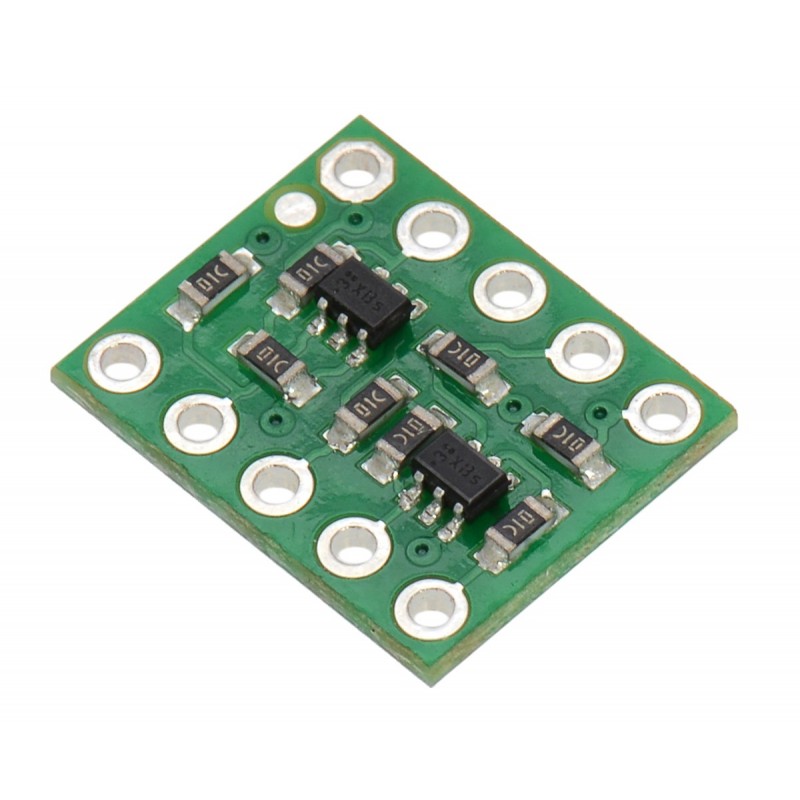

This tiny logic level shifter features four bi-directional channels, allowing for safe and easy communication between devices operating at different logic levels. It can convert signals as low as 1.5 V to as high as 18 V and vice versa, and its four channels are enough to support most common bidirectional and unidirectional digital interfaces, including I²C, SPI, and asynchronous TTL serial.
As digital devices get smaller and faster, once ubiquitous 5 V logic has given way to ever lower-voltage standards like 3.3 V, 2.5 V, and even 1.8 V, leading to an ecosystem of components that need a little help talking to each other. For example, a 5 V part might fail to read a 3.3 V signal as high, and a 3.3 V part might be damaged by a 5 V signal. This level shifter solves these problems by offering bidirectional voltage translation of up to four independent signals, converting between logic levels as low as 1.5 V on the lower-voltage side and as high as 18 V on the higher-voltage side, and its compact size and breadboard-compatible pin spacing make it easy to integrate into projects.
The logic high levels on each side of the shifter are achieved by 10 kΩ pull-up resistors to their respective supplies; these provide quick enough rise times to allow decent conversion of fast mode (400 kHz) I²C signals or other similarly fast digital interfaces (e.g. SPI or asynchronous TTL serial). External pull-ups can be added to speed up the rise time further at the expense of higher current draw. See the schematic diagram below for more information.
This logic level converter requires two supply voltages: the lower-voltage logic supply (1.5 V to 7 V) connects to the LV pin and the higher-voltage supply (LV to 18 V) connects to the HV pin. The HV supply must be higher than the LV supply for proper operation. Logic low voltages will pass directly from Hx to the corresponding Lx (and vice versa), while logic high voltages will be converted between the HV level to the LV level as the signal passes from Hx to Lx or Lx to Hx.
The level shifter circuit does not require a ground connection to either device, so there are no ground pins on the board. (Some competing level shifter modules provide ground connections that simply act as a pass-through; we have opted to leave these off and make the board smaller.) The two devices being connected through the level shifter must still share a common ground.
The picture below shows a level-shifted TTL serial connection (RX and TX) between a 5 V Arduino Uno and a 3.3 V Raspberry Pi.

Using the 4-channel bidirectional logic level shifter to create a serial connection between a 5 V Arduino Uno and a 3.3 V Raspberry Pi
Manufacturer BTC Korporacja sp. z o. o. Lwowska 5 05-120 Legionowo Poland sprzedaz@kamami.pl 22 767 36 20
Responsible person BTC Korporacja sp. z o. o. Lwowska 5 05-120 Legionowo Poland sprzedaz@kamami.pl 22 767 36 20
BOB-11771 Voltage-Level Translator - TXB0104 Breakout
Bi-directional 8-channel logic level converter module (1.2-3.6V to 1.7-5.5V) based on TXS0108 chip.
Bi-directional 8-channel logic level converter module (1.2-3.6V to 1.7-5.5V) based on TXB0108 chip.
Voltage-to-current converter module designed for devices with a current signal input. It allows you to linearly convert voltage signals from 0 to 5 V into current signals from 0 to 20 mA
8-channel voltage level converter allowing for connection of systems operating with the voltage level of 1.8 V, 2.5 V, 3.3 V and 5 V. SparkFun BOB-19626
3V/5V voltage level converter module with built-in Step-Up converter. Allows development boards operating at 3V to be connected to a device requiring a higher operating voltage of 5V for I2C communication. Adafruit 5649
A module with a set of resistors and mechanical switches that allows you to adjust the resistance in the range from 0 to 999990 Ω. SparkFun KIT-13006
No product available!
8-channel voltage level converter module with an input voltage of 12 V and an output voltage of 3.3 V. Unidirectional, based on resistor dividers. Numato Lab NLVD00008
BOB-11771 Voltage-Level Translator - TXB0104 Breakout
A module enabling the conversion of input voltage in the range from 1.8 V to 5.3 V into the appropriate negative output voltage. It offers high efficiency in excess of 80%, making it ideal for applications where a lower power negative supply is required, such as biasing sensors or op-amp circuits. Pololu 2839
8-channel Bi-directional Logic Level Converter - TXB0108, RoHS
8-bit voltage level converter with TXB0108 integrated circuit. It acts as a bridge between applications with different source voltages and input and output voltage levels. SB Components 21772
Module with a voltage divider. Equipped with a Grove connector, it allows the input voltage to be reduced by 3 or 10 times. Seeed Studio 104020000
No product available!
Bi-directional 8-channel logic level converter module (1.2-3.6V to 1.7-5.5V) based on TXB0108 chip.
Module with a voltage level converter from 5 V to 3.3 V, intended for use in the STEMMA QT/Qwiic system. It has a built-in voltage stabilizer providing 3.3 V power supply with a current of up to 500 mA. Adafruit 5637
4-channel converter of voltage levels 3.3V/5V that allows you to connect systems operating at a lower voltage to those powered by a higher voltage
Bi-directional 8-channel logic level converter module (1.2-3.6V to 1.7-5.5V) based on TXS0108 chip.
A small module with a voltage level converter that allows easy conversion of signals from 3.3V to 5V. It is compatible with a wide range of LED strips, such as NeoPixel. With easy, solderless installation, it supports up to two signal lines, ensuring smooth operation of LEDs at frequencies up to 10 MHz. Adafruit 6066

This tiny logic level shifter features four bi-directional channels, allowing for safe and easy communication between devices operating at different logic levels. Pololu - 2595
